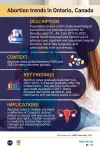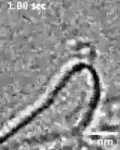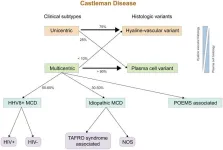(Press-News.org) PHILADELPHIA – The American Association for Cancer Research (AACR) is pleased to announce the recipients of the 2025 AACR June L. Biedler Prize for Cancer Journalism in the following categories:
Magazine
“Targeting Cancer, Sparing Patients”
By Jyoti S. Madhusoodanan (Photo), Scientific American
Newspaper
“Fighting stigma, fighting cancer: The rising threat of male breast cancer in Kenya”
By Pauline Ongaji Ogada (Photo), Nation
Online/Multimedia
“Farewell, my stomach”
By Teresa Firmino (Photo) and Joana Martins Gonçalves (Photo), Publico
“Women who are blind play a critical role in identifying breast cancers”
By Kamala Thiagarajan (Photo), National Public Radio
“Undetected and untreated amid war: Gaza's women are suffering in silence this Breast Cancer Awareness Month”
By Rasha Salman Mohammed Abu Jalal (Photo), The New Arab
Television/Radio/Podcast
“O Câncer nas Mulheres da Amazônia - Cancer in Amazonian Women”
By Giulia Gazetta Scarano (Photo), Marcela Varasquim (Photo), and Larissa Werren (Photo), Repórter Record Investigação
The prize recipients will be recognized on Sunday, April 27, during the Opening Ceremony at the AACR Annual Meeting 2025 in Chicago, Illinois. The AACR Annual Meeting brings together thousands of researchers, clinicians, survivors, patients, and advocates to share the latest advances in cancer science and medicine.
The AACR June L. Biedler Prize for Cancer Journalism was established in 2015 to raise awareness of the critical role that the media play in educating the public about cancer and cancer research. The prize showcases outstanding examples of cancer journalism and recognizes individual professional journalists who have produced accurate, informative, and compelling stories that enhance the public’s understanding of cancer, cancer research, cancer advocacy, or cancer policy. The prize is named in honor of June L. Biedler, PhD, and is supported by a generous bequest she made to the AACR.
“The AACR is honored to recognize these remarkable journalists with the 2025 AACR June L. Biedler Prize for Cancer Journalism,” said Margaret Foti, PhD, MD (hc), chief executive officer of the AACR. “This year’s recipients hail from six different countries and, through their stories, bring to light important progress and challenges in cancer science and medicine. Together, the winning submissions convey the global impact of this terrible disease and remind us that combating cancer will require dedicated international collaboration. We are thankful for Dr. Biedler’s generous gift that allows us to celebrate the critical role of the media in educating people around the world about cancer and cancer research.”
“I’ve had the honor of judging the Biedler Prize for the past decade, and I am thrilled to say that the reporting and storytelling by our entrants continues to amaze me,” said Clifton Leaf, adjunct professor at Columbia Journalism School, former editor-in-chief of Fortune, visiting member of the Ellison Medical Institute, and chair of the Biedler Prize since 2017. “This year’s winners take us on a stunning journey across five continents, showing in powerful detail the challenges that those with cancer too often face—and the wellspring of innovative science and care that’s being brought to meet them.”
ABOUT THE WINNING SUBMISSIONS
Magazine
“Targeting Cancer, Sparing Patients” by Jyoti S. Madhusoodanan, Scientific American
In this feature story, Jyoti S. Madhusoodanan takes a deep dive into the history and science of antibody-drug conjugates (ADCs), a new class of drugs that target a wide range of cancers. Scientists have pursued the dream of targeted cancer treatments for nearly a century, and ADCs mark a significant milestone in that quest. Madhusoodanan expertly tells an insightful story that balances science and clinical impact, taking readers on a tour of the science behind these drugs, researchers’ motivations and persistence in developing such therapies, and the deep joy doctors have felt to see their patients benefit from ADCs during clinical trials and beyond.
Newspaper
“Fighting stigma, fighting cancer: The rising threat of male breast cancer in Kenya” by Pauline Ongaji Ogada, Nation
In this article, Pauline Ongaji Ogada skillfully integrates facts, science, and personal stories to explore the stigma surrounding male breast cancer and the challenges faced in diagnosis and treatment. Societal perceptions often lead to misdiagnosis and delayed care, as men are typically viewed as less likely to develop the disease. Ongaji shares the breast cancer journeys of two men, who both faced significant financial burdens and emotional distress following their diagnoses. Their narratives highlight the urgency of addressing these misconceptions while also reflecting the resilience of individuals battling a condition shrouded in stigma.
Online/Multimedia
“Farewell, my stomach” by Teresa Firmino and Joana Martins Gonçalves, Publico
Through illustration and animation, Teresa Firmino and Joana Martins Gonçalves masterfully translate complex scientific findings on hereditary diffuse gastric cancer (HDGC)—a rare type of cancer that grows in the stomach—by telling the story of a young man’s diagnosis and the aftermath of his passing. His family went on to get tested for the genetic mutation that increases the risk of developing HDGC, and many underwent a total gastrectomy as a preventative measure. The story weaves together the patients’ viewpoints and the perspective of the scientists who research the genetic basis of HDGC, highlighting the power of cancer research, and specifically genetic testing.
“Women who are blind play a critical role in identifying breast cancers” by Kamala Thiagarajan, National Public Radi
In this piece, Kamala Thiagarajan spotlights a new initiative to address a common problem in breast cancer screening around the world. For many reasons, women may find a mammogram invasive, or in conservative cultures, they may feel ashamed to undergo one, leading to a delayed diagnosis of breast cancer. “Discovering Hands” is a global project that trains people who are blind to perform comprehensive breast exams. The idea was to leverage the blind examiner's sense of touch, which studies have shown is more acute than that of sighted people. The medical tactile examiners were 30% better at detecting even the smallest lumps and bumps in breast tissue than doctors due to their heightened sense of touch. Thiagarajan’s story focuses on the program’s impact in India, highlighting the effect it has had not only on patients but also on the women employed by hospitals and supported by the Discovering Hands program, who might otherwise be unable to find a job because of their condition.
“Undetected and untreated amid war: Gaza's women are suffering in silence this Breast Cancer Awareness Month” by Rasha Salman Mohammed Abu Jalal, The New Arab
In this report, Rasha Salman Mohammed Abu Jalal brings to light the experiences of breast cancer patients in Gaza who face not only the burden of illness but also the compounded challenges of war, displacement, and limited access to healthcare. The piece exposes the realities of life in the midst of conflict, where basic medical care is out of reach and crossing borders for treatment is impossible. This story is rich in personal testimonies, making it powerful and effective in conveying the barriers for cancer patients in war zones.
Television/Radio/Podcast
“O Câncer nas Mulheres da Amazônia - Cancer in Amazonian Women” by Giulia Gazetta Scarano, Marcela Varasquim, and Larissa Werren, Repórter Record Investigação
In this impactful video report, Giulia Gazetta Scarano, Marcela Varasquim, and Larissa Werren shed light on the difficulties women in the Amazon face when diagnosed with cancer, where medical care is not available. Patients need to travel long distances, some by boat, to receive specialized care at the only public hospital dedicated to cancer treatment in the state. Through this story, Gazetta Scarano, Varasquim, and Werren draw attention to an underreported issue and emphasize the need for more resources for this vulnerable patient population. END
AACR announces recipients of the 2025 AACR June L. Biedler Prize for Cancer Journalism
2025-04-11
ELSE PRESS RELEASES FROM THIS DATE:
Human-AI relationships pose ethical issues, psychologists say
2025-04-11
It’s becoming increasingly commonplace for people to develop intimate, long-term relationships with artificial intelligence (AI) technologies. At their extreme, people have “married” their AI companions in non-legally binding ceremonies, and at least two people have killed themselves following AI chatbot advice. In an opinion paper publishing April 11 in the Cell Press journal Trends in Cognitive Sciences, psychologists explore ethical issues associated with human-AI relationships, including their potential to disrupt human-human relationships and give harmful advice.
“The ...
Abortion rates remain relatively stable in Canada, while rates spike in UK, Europe, and US
2025-04-11
Vancouver, BC, April 11, 2025 – A new study finds that, unlike countries across the UK and Europe, abortion rates did not spike in Ontario, Canada from 2020-2022.
Following decades-long declines in nearly all high-income settings, abortion rate trends reversed between 2020 and 2022 in many countries. For example, 2022 and 2023 saw the highest abortion rates on record in Scotland, England, and Wales.
Researchers from the University of British Columbia and ICES found that, after accounting for changes in the abortion rate when the ...
Hundred-year storm tides will occur every few decades in Bangladesh, scientists report
2025-04-11
Tropical cyclones are hurricanes that brew over the tropical ocean and can travel over land, inundating coastal regions. The most extreme cyclones can generate devastating storm tides — seawater that is heightened by the tides and swells onto land, causing catastrophic flood events in coastal regions. A new study by MIT scientists finds that, as the planet warms, the recurrence of destructive storm tides will increase tenfold for one of the hardest-hit regions of the world.
In a study that will appear in One Earth, the scientists ...
Kidney function following COVID-19 in children and adolescents
2025-04-11
About The Study: In this large U.S. cohort study of children and adolescents, SARS-CoV-2 infection was associated with a higher risk of adverse postacute kidney outcomes, particularly among those with preexisting chronic kidney disease or acute kidney injury, suggesting the need for vigilant long-term monitoring.
Corresponding Author: To contact the corresponding author, Yong Chen, PhD, email ychen123@pennmedicine.upenn.edu.
To access the embargoed study: Visit our For The Media website ...
Risk factors for severe disease among children hospitalized with RSV
2025-04-11
About The Study: In this cohort study of children hospitalized with respiratory syncytial virus (RSV) in 2022 and 2023, severe RSV disease was more likely among those age 2 or older with pulmonary and neurologic, neuromuscular, or developmental conditions. For children younger than 2 years, age younger than 6 months and prematurity were the main risk factors. These findings support prevention strategies for all younger children, including premature infants, with potential benefit for children age 2 or older ...
Watch a live catalytic event in real time
2025-04-11
A Northwestern University-led international team of scientists has, for the first time, directly observed catalysis in-action at the atomic level.
In mesmerizing new videos, single atoms move and shake during a chemical reaction that removes hydrogen atoms from an alcohol molecule. By viewing the process in real time, the researchers discovered several short-lived intermediate molecules involved in the reaction as well as a previously hidden reaction pathway.
The observations were made possible by single-molecule atomic-resolution time-resolved electron microscopy (SMART-EM), a powerful instrument that enables researchers to watch individual ...
Top medical research expert Mark T. Esser named inaugural head of UVA’s Manning Institute
2025-04-11
The University of Virginia has named Mark T. Esser, PhD, a premier expert in the development of new medical treatments and tests, to lead the upcoming Paul and Diane Manning Institute of Biotechnology and bring to life the institute’s ambitious plans for a healthier tomorrow for people across the world.
In his role as the inaugural chief scientific officer and head of the Manning Institute, Esser will be charged with capitalizing on the cutting-edge biomedical research under way at UVA and UVA Health to tackle some of the greatest challenges in medicine and accelerate the development of new treatments and cures.
In ...
Protein GSK3β offers new angle on overcoming melanoma drug resistance
2025-04-11
“Inhibitors of GSK3β reduce the cell viability of BRAFi-resistant melanoma cell lines and thus may holds promise as a novel strategy to overcome BRAFi resistance and melanoma progression.”
BUFFALO, NY – April 11, 2025 – A new research perspective was published in Oncotarget, Volume 16, on April 4, 2025, titled “GSK3β activation is a key driver of resistance to Raf inhibition in BRAF mutant melanoma cells.”
In this work, first author Diana Crisan and corresponding author Abhijit Basu from the University Hospital Ulm led ...
Mimickers and associated neoplasms of Castleman disease
2025-04-11
Castleman disease (CD) is a rare, non-clonal lymphoproliferative disorder that manifests with a wide range of histologic and clinical features. It is classified clinically into unicentric (UCD) and multicentric (MCD) forms and histopathologically into hyaline vascular (HV-CD), plasma cell (PC-CD), and mixed types. UCD typically presents as an isolated lymph node enlargement, often asymptomatic, whereas MCD involves multiple nodal sites and systemic symptoms. MCD may be associated with human herpesvirus 8 (HHV8), idiopathic origins (iMCD), POEMS syndrome, or TAFRO ...
Preserving and using the deep sea: scientists call for more knowledge to enable sustainable management
2025-04-11
Where does the deep sea begin? Definitions vary across science and legal frameworks. For the purposes of their joint analysis, the members of the European Marine Board’s (EMB) Deep Sea and Ocean Health Working Group defined the deep sea as the water column and seabed below 200 metres. Below this point, sunlight barely penetrates the water, and the habitat changes dramatically. According to this definition, the deep sea accounts for about 90 per cent of the ocean’s volume. Its importance for ...




